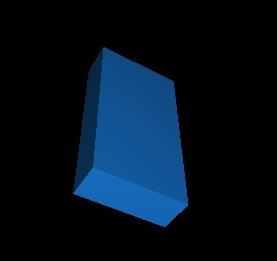3D-s kocka rajzolása DirectX segítségével
Eza kis program az itt bemutatott áramkör által küldött adatokat vizualizálja egy 3D-s téglatest segítségével. A rajzoláshoz DirectX-et választottam, segítségével nagyon egyszerűen megoldható az objektum forgatása.

A projekthez szükséges a directx SDK telepítése, melyet a microsoft honlapjáról lehet letölteni. A téglatestet „UserControl”-ba készítettem el, így könnyen felhasználható más projekteknél is.
Directx Inicializálás
A konstruktorba került:
private Device device; //Directx device object
private CustomVertex.PositionNormalColored[] verts; //Coordinátákat tároló tömb
public DXGyro()
{
InitializeComponent();
verts = CreateCube(); //Coordinátákat megadó függvény
PresentParameters pp = new PresentParameters(); //Directx beállítások
pp.PresentFlag = PresentFlag.LockableBackBuffer;
pp.Windowed = true;
pp.SwapEffect = SwapEffect.Discard;
pp.BackBufferWidth = this.Width;
pp.BackBufferHeight = this.Height;
device = new Device(0, DeviceType.Hardware, this,
CreateFlags.HardwareVertexProcessing, pp); //eszköz inicializálása
}
A koordináták megadása
Itt csak egy négyzetet mutatok be a terjedelem miatt. Minden ábrát háromszögekből (primitívekből) lehet kirajzolni. Így egy négyzethez két háromszög koordinátáit kell megadnunk:
protected CustomVertex.PositionNormalColored[] CreateCube()
{
float X2 = 0.5f;
float Y2 = 0.2f;
float Z2 = 1.0f;
CustomVertex.PositionNormalColored[] verts =
new CustomVertex.PositionNormalColored[36];
verts[0] = new CustomVertex.PositionNormalColored(new Vector3(-X2, Y2, Z2),
new Vector3(0, 0, 1), _cubecolor.ToArgb());
verts[1] = new CustomVertex.PositionNormalColored(new Vector3(-X2, -Y2, Z2),
new Vector3(0, 0, 1), _cubecolor.ToArgb());
verts[2] = new CustomVertex.PositionNormalColored(new Vector3(X2, Y2, Z2),
new Vector3(0, 0, 1), _cubecolor.ToArgb());
verts[3] = new CustomVertex.PositionNormalColored(new Vector3(-X2, -Y2, Z2),
new Vector3(0, 0, 1), _cubecolor.ToArgb());
verts[4] = new CustomVertex.PositionNormalColored(new Vector3(X2, -Y2, Z2),
new Vector3(0, 0, 1), _cubecolor.ToArgb());
verts[5] = new CustomVertex.PositionNormalColored(new Vector3(X2, Y2, Z2),
new Vector3(0, 0, 1), _cubecolor.ToArgb());
return verts;
}Kamera nézőszög és megvilágítás beállítása
protected void SetupCamera()
{
//Perspektíva és orientáció
device.Transform.Projection = Matrix.PerspectiveFovLH((float)Math.PI / 4.0f,
(float)this.Width / (float)this.Height, 1.0f, 100.0f);
device.Transform.View = Matrix.LookAtLH(new Vector3(0, 0, 5.0F), new Vector3(),
new Vector3(0, 1, 0));
device.RenderState.Lighting = true;
//Egyszerű pont megvilágítás
device.Lights[0].Type = LightType.Point;
device.Lights[0].Position = new Vector3(0, 0, 10);
device.Lights[0].Ambient = System.Drawing.Color.White;
device.Lights[0].Attenuation0 = 0.8F;
device.Lights[0].Attenuation1 = 0.02F;
device.Lights[0].Range = 1000.0F;
device.Lights[0].Enabled = true;
}A rajzolás
protected void DoDraw()
{
SetupCamera();
//Először mindíg törölni kell a képernyőt
device.Clear(ClearFlags.Target, Color.Black, 1, 0);
device.BeginScene();
device.VertexFormat = CustomVertex.PositionNormalColored.Format;
//Forgatás
device.Transform.World = Matrix.RotationYawPitchRoll(0, (float)_Pitch *
(float)Math.PI / 180.0f, -(float)_Roll * (float)Math.PI / 180.0f);
//A koordináták átadása, mivel háromszöget rajzol a koordináták harmadát kell megadni
device.DrawUserPrimitives(PrimitiveType.TriangleList, 12, verts);
device.EndScene();
device.Present();
}
A komplett forráskód githubon elérhető.
Facebook Comments
